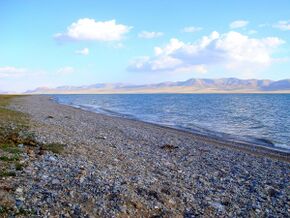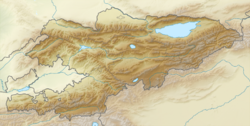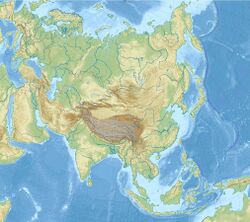Earth:Song Kol Lake
| Song-Köl Lake | |
|---|---|
 Northern shore of the Song-Köl | |
| Coordinates | [ ⚑ ] : 41°50′N 75°10′E / 41.833°N 75.167°E |
| Type | Endorheic Mountain lake |
| rivers, streams, precipitation">Primary inflows | Glaciers |
| rivers, streams, evaporation">Primary outflows | Evaporation and the Song Köl River |
| Basin countries | Kyrgyzstan |
| Surface area | 270 km2 (100 sq mi) |
| Max. depth | 13 m (43 ft) |
| Water volume | 2.64 km3 (2,140,000 acre⋅ft) |
| Surface elevation | 3,016 m (9,895 ft) |
| Official name | Son-Kol Lake |
| Designated | 23 January 2011 |
| Reference no. | 1943[1] |
Song Köl (also Son Kul, Songköl, Song-Köl; Kyrgyz: Соңкөл, IPA: [sóɴkœl], literally "following lake") is an alpine lake in northern Naryn Province, Kyrgyzstan. It lies at an altitude of 3016 m, and has an area of about 270 km2 and volume of 2.64 km3. The lake's maximum length is 29 km, breadth about 18 km, and the deepest point is 13.2 m. It is the second largest lake in Kyrgyzstan after Issyk Kul Lake, and the largest fresh water lake in Kyrgyzstan.
Geography
High altitude Song Köl belongs to Naryn River basin. The lake sits in the central part of Song Köl Valley surrounded by Songköl Too ridge from the north, and Borbor Alabas and Moldo Too mountains from the south. Hydrologically, Song Köl basin is characterized by poorly developed surface stream flows, and substantial subsurface flow. Four perennial rivers - Kum-Bel', Ak-Tash, Tash-Dobo, and Kara-Keche - disgorge themselves into the lake. In the south-east, the structural high is cut through by Song Köl river that flows into Naryn River.[2]
Environment
Climate
The mean temperature in the lake basin is −3.5 °C (25.7 °F) with mean temperature of −20 °C (−4 °F) in January, and 11 °C (52 °F) in July. Annual precipitation averages 300–400 mm from April to October, and 100–150 mm from November to March. Snow cover in the lake basin persists for 180 to 200 days a year. In winter the lake surface freezes, the ice becoming as much as 1-1.2 m thick. The ice on the Song Köl begins to thaw in the middle or at the end of April, and completely disappears by late May.[3][4]
Ecology
In 2011, Song Köl was designated by Kyrgyzstan as its third Wetland of International Importance for the Ramsar List.[5]
References
- ↑ "Son-Kol Lake". https://rsis.ramsar.org/ris/1943.
- ↑ (in ru). Bishkek: Academy of Sciences of Kyrgyz SSR. 1987. pp. 156.
- ↑ Information Sheet on Ramsar Wetlands (RIS), http://www.ramsar.wetlands.org/Database/Searchforsites/tabid/765/Default.aspx, retrieved October 30, 2012
- ↑ (in ru). Bishkek: Chief Editorial Board of Kyrgyz Soviet Encyclopedia. 1994. pp. 512. ISBN 5-89750-009-6.
- ↑ "Kyrgyz Republic names high altitude lake". http://www.ramsar.org/cda/en/ramsar-news-archives-2011-son-kol-lake/main/ramsar/1-26-45-489%5E25068_4000_0__.



